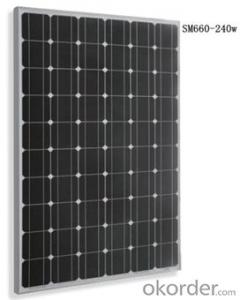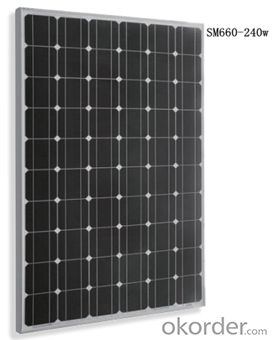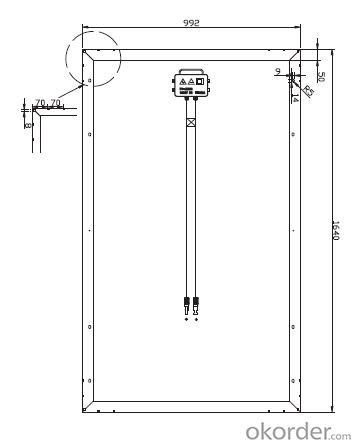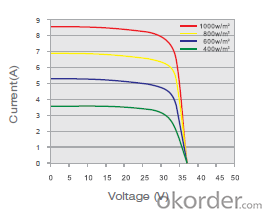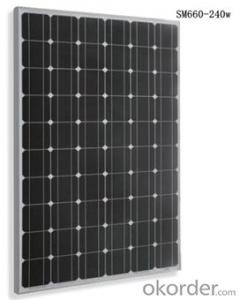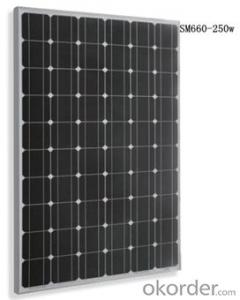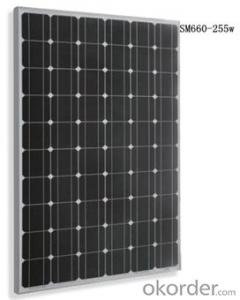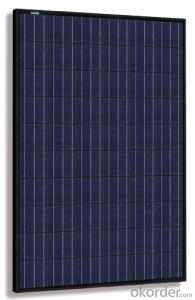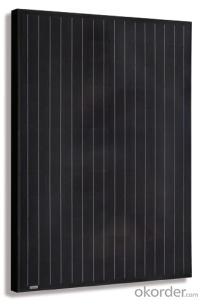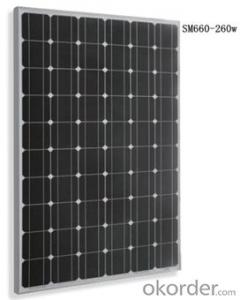Solar Panels Germany Monocrystalline Solar Module SM660-240W
- Loading Port:
- Shanghai
- Payment Terms:
- TT OR LC
- Min Order Qty:
- 25 set
- Supply Capability:
- 8000 set/month
OKorder Service Pledge
OKorder Financial Service
You Might Also Like
Product Description:
1.Structure of Monocrystalline Solar Module SM596 240W Series Description:
Monocrystalline Solar Module SM596 240W: High efficiency crystalline solar cell. Even if under the weak light, the solar module can produce maximum power output.
II Tempered glass (toughened glass): Anti-reflecting coating and high transmission rate glass increase the power output and mechanical strength of solar module.
III EVA and TPT: Using high quality EVA and TPT to prevent destroying and water.
IV AI frame: Without screw, rner connection. 6 holes on the frame can be installed easily.
V Junction box: Multi function junction box with water proof.
VI Long lifetime: ≥25 years; Less power decrease.
VII Good performance of preventing from atrocious weather such as wind and hails.
VIII Resisting moisture and etching effectively, not effected by geology.
IX The certificate issued by international authority: TUV, IEC, CE.ISO9001.MCS
2. Standard Test Conditions of Monocrystalline Silicon Solar Panel:
The opto-electrical specifications shown below are stabilized values being measured at Standard Test Conditions, Irradiance: 1000W/m2, Spectrum: AM1.5 at 25°C, The info below is subject to manufacturing tolerances. Where appropriate minutes of measurement are available and are used for the dimensioning of the installation.
Advantages of Polycrystalline Silicon Solar Panel
• 25 year transferrable power output warranty: 10 years / 90%, 25 years / 80%*
• 12 year material and workmanship warranty
• Timeliness of delivery
• Quality Products certified (TUV, IEC, CE.ISO9001.MCS)
3. Characteristics of Monocrystalline Silicon Solar Panel:
• Guaranteed tolerance +3%
• High manufacture standards
• Reliable power output
• High module efficiency
• Module efficiency up to 15.5%
• Cells efficiency up to 17.6%
• Strong compressive strength
• Certified to withstand high wind of 2400Pa
4. Solar Panel Images
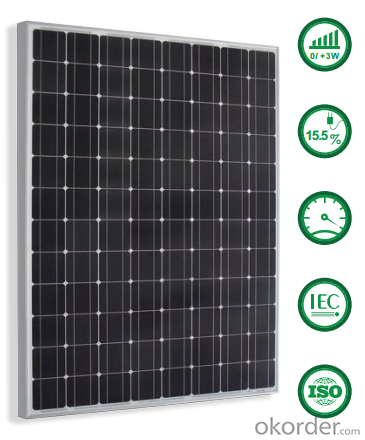
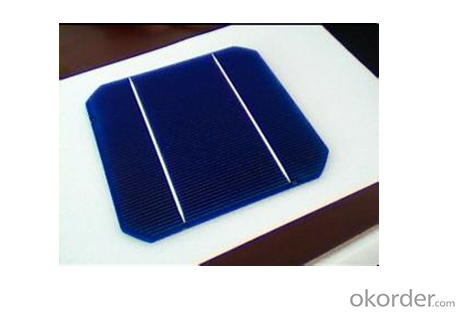


5. Monocrystalline Silicon Solar Panel Specification
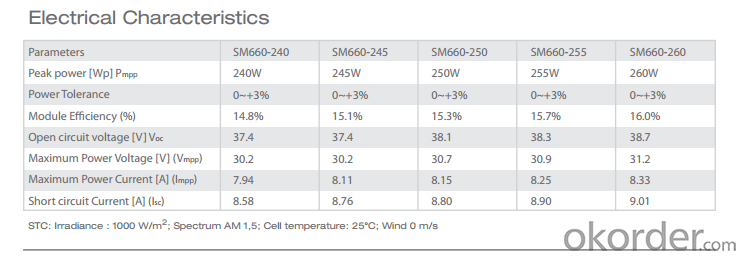
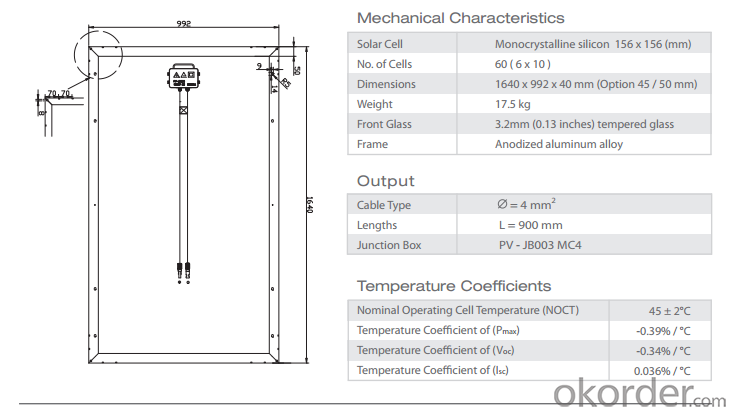


6.FAQ
We have organized several common questions for our clients,may help you sincerely:
①How about your company?
We are a private-owned high-tech company who specializes in developing, manufacturing and marketing of silicon ingots, solar wafer, solar cells, solar modules, PV systems and solar applications products.
At present, We has one research & development team, whose members are well-known experts in photovoltaic area. We also have advanced production and test equipment.
②How to guarantee the quality of the products?
Our products have been certified by CE, CEC,MCS, IEC61215, IEC61730 and ISO9001.
• 25 year transferrable power output warranty: 10 years / 90%, 25 years / 80%*
• 12 year material and workmanship warranty
• Timeliness of delivery
• Quality Products certified (TUV, IEC, CE.ISO9001.MCS)
③How long can we receive the product after purchase?
In the purchase of product within three working days, We will arrange the factory delivery as soon as possible. The pecific time of receiving is related to the state and position of customers.Commonly 7 to 10 working days can be served.
- Q: Can solar panels be used to power a public transportation system?
- Yes, solar panels can be used to power a public transportation system. Solar energy can be harnessed through photovoltaic panels and converted into electricity to power electric buses, trams, or trains. This renewable energy source can significantly reduce carbon emissions and dependence on fossil fuels in public transportation, making it a more sustainable and environmentally friendly option.
- Q: What are the different applications for solar panels for residential use? How many should I purchase if the avg panel produces 80 watts .
- Solar is a system, not just panels. Here is a link to the pro's that do this daily. You need to do the inside of your home, before you do the outside. Only then will solar work for you.
- Q: How much electricity does a solar panel produce?
- The amount of electricity a solar panel produces depends on various factors such as its size, efficiency, location, and weather conditions. On average, a typical residential solar panel can produce anywhere between 250 to 400 watts of electricity per hour.
- Q: Can solar panels be installed on ground-mounted structures?
- Yes, solar panels can be installed on ground-mounted structures. Ground-mounted solar panel systems are commonly used when there is limited space on rooftops or when the optimal orientation and tilt angles cannot be achieved on a building's roof. Ground-mounted structures provide flexibility in panel placement, allowing for optimal sun exposure and ease of maintenance.
- Q: Can solar panels be installed in a community or neighborhood?
- Yes, solar panels can definitely be installed in a community or neighborhood. In fact, installing solar panels at a community or neighborhood level can have several benefits. It allows for a more cost-effective approach, as the installation and maintenance expenses can be shared among multiple households. Moreover, it promotes a more sustainable and environmentally friendly energy source, reducing reliance on fossil fuels and lowering carbon emissions. Additionally, community solar projects encourage collaboration and community engagement, fostering a sense of unity and shared responsibility towards a greener future.
- Q: How do I choose the right size of solar panels for my home?
- To choose the right size of solar panels for your home, you need to consider the available roof space, your energy consumption, and your budget. First, assess the area on your roof that can accommodate solar panels and determine its orientation and shading. Then, calculate your average monthly electricity usage to estimate the system size required to meet your needs. Lastly, take your budget into account and consider the cost-effectiveness of different panel sizes. Consulting with a solar professional can also provide valuable guidance in determining the right size for your specific requirements.
- Q: Can solar panels be installed on a greenhouse?
- Yes, solar panels can be installed on a greenhouse. In fact, it is a common practice to install solar panels on greenhouses to harness solar energy for both power generation and to provide supplemental lighting and heating for the plants inside.
- Q: Most solar panels (the flat ones that go onto roofs of houses) reject electricity produced by the panels if they are too low in voltage. For example, on a cloudy day, although the panels may still get some sunlight to produce some electricity, it is rejected because its too low in voltage. So, does anyone have any ideas?
- What about a battery bank as a sink? By that, I mean the batteries absorb the low/high voltage, and if the solar panels do cut out, then the batteries pick up the load and keep the inverter going. Just a thought.
- Q: Since plants have been populating this earth for the past 475 million years I think they have evolved to gain the most sun with their greenery. If scientists used heat sensors to find the hot spots of trees and trim all of the leaves that don't quot;providefor the plant, then maybe that trimmed tree could be used to become a solar quot;panelquot;. I believe that each individual leaf could be replaced by a small solar panel and the wood of the tree would be wiring that would root all of the solar panels to a generator.
- From the vantage point of a scientist and an engineer, you have a whole host of problems to overcome. The mass of solar cells cannot be supported by most leaves much less allow the leaves to turn toward the sun as they naturally do. The wood and other structures of a tree are terrible conductors and wouldn't serve as efficient power transmitters. There are issues of damaging the health of the tree by interrupting the process of photosynthesis in favor of solar energy collection, and many other issues. However, I can tell you that solar power does use several principals that you have observed in trees. For example, solar collectors are almost always oriented to face toward the sun. Many adjust with the time of day and seasons to be optimally oriented to collect the sun's rays. Much like leaves in many plants are not static but change position to optimize their angle to the sun. Also, many solar cells are now designed with a membrane structure which offer several advantages. So you see many of your observations have found their way into practical application in solar power production.
- Q: Need solar panel info with dimensions and also the total cost of the whole equipment for setting up of the required solar panels for a 2-story home
- There are many, upon many variations of equipment needed for a complete solar home. I would call several contractors in your area that deals with it and get estimates. You have to look at what your wattage diet is at your home. How many watts are you using for your AC and heat. Which can vary by age, efficiency, insulation of home, etc. Look at your electric bill for a normal summer month and a normal winter month, then estimate your heating and cooling (Sometimes can be as much as 70% of the bill). You will see on your bill your toal kilowatt hours. ( Kilowat = 000 Watts) Solar systems can start as low as $2.00/watt, but can rapidly approach $20.00/watt depending on the difficulty of application etc.... Here is the great thing, in many areas of the country there may be rebates from the county or state. And what you don't use can be fed back into the grid, and you get paid for it. But as always - Call a quailified contractor and get the right system for your home.
Send your message to us
Solar Panels Germany Monocrystalline Solar Module SM660-240W
- Loading Port:
- Shanghai
- Payment Terms:
- TT OR LC
- Min Order Qty:
- 25 set
- Supply Capability:
- 8000 set/month
OKorder Service Pledge
OKorder Financial Service
Similar products
Hot products
Hot Searches
Related keywords
